
Purpose
A goods and services proposal is “an offer to supply a tangible product (a fleet of automobiles), a service (building maintenance), or some combination of the two (the construction of a building)" (Markel and Selber, 427).
A goods and services proposal is often called either a sales proposal or a business proposal.
What are the main objectives of a goods and services proposal?
- Convince the client of their need for the product or service. Your duty as a proposal writer and objective third-party expert is to educate the client on their needs.
- Prove to the client the benefits that this product or service will bring to them. More importantly, demonstrate why your employer can deliver the product or service better than the client can themselves.
- Describe the justification of the prospective client’s investment into the product or service and provide reasons why they are right to invest their time and money.
Audience
When writing your goods and services proposal, it is best to know a significant amount about your audience. One common scenario is that you will be writing your proposal in response to a request for proposal (RFP). An RFP is a document
written by a company that solicits proposal for a good or service. If you are writing in this situation, it is likely that you would have been provided with information pertaining to the prospective client’s needs.
In this scenario, highlight which aspects of their needs your company specializes in the most or is most proficient in. If your employer did not first receive an RFP, you will have to conduct some research to learn more about your
prospective client. Research may include prospective client research, market research, feasibility research, and data gathering.
Examples
"Bar and Restaurant Business Proposal"
"Collaborative Music Streaming Application Proposal"
Formatting
Goods and services proposals should follow this general format.
Introduction
- Discuss the nature of your client's need.
- Discuss your knowledge of the prospect’s business and how your proposal is organized.
Problem Identification
- Discuss your understanding of the client’s problem or need.
- Discuss and expand the definition of their problems by adding your own concerns, which will show your knowledge and deep insight into the topic at hand.
Approach
- Discuss the objectives and scope of work that your prospect will receive.
- Outline the schedule for delivery and completion of key items.
- Make sure the schedule you are outlining will be followed, as this will gain trust with your prospective client.
Deliverables
- Provide the details of your approach so that your prospective client can understand it more clearly.
- Outline the process with which you will fulfill their needs, including the particular deliverables that come with it.
- Be careful not to be too specific in offering suggestions to your prospective client; they may discard your idea because they have already thought of it or may take the suggestion and do it themselves.
Features and Benefits
- Discuss the benefits your prospective client can expect from using your particular products or services.
- Discuss any upside your product or service can provide to the prospective client. How will this product or service improve the prospective client’s business as a whole?
- In this section, keep your prospective client’s goals in mind. Try to tie in any benefits of your services to their goals they hope to achieve.
Costs
- The placement of this section is key. Make sure to include this section after you have explained your approach and the benefits you will be providing.
- If you include a section about costs too early in your proposal, the prospective client will not be in the mood to hear more about your pitch.
- When writing your costs, break them up into parts, preferably numbered.
- Try to make them as detailed as possible as not to avoid confusion when the services are delivered.
Conclusion
- To conclude, remind the prospective client why you are the right choice for their need.
- Discuss a starting date your company will be available to work or a delivery date you they can expect your company to be finished by.
- End the proposal with a final statement of interest in which you restate your desire to be hired for this project.
Sources
Edward Lowe Foundation
Markel & Selber, Technical Communication, 2018, Bedford/St. Martin’s
by Jakob Cole

